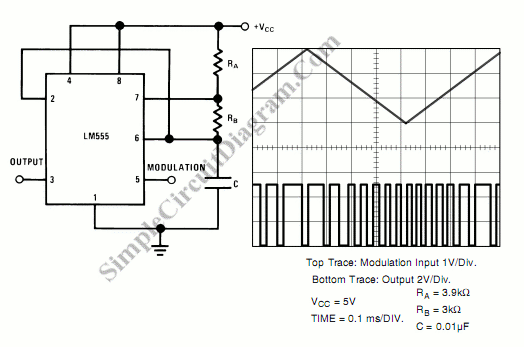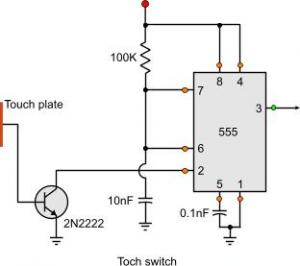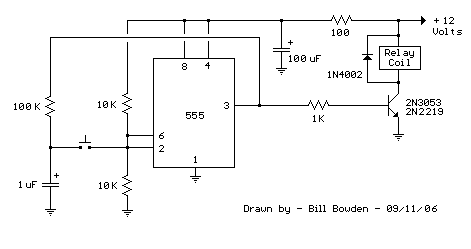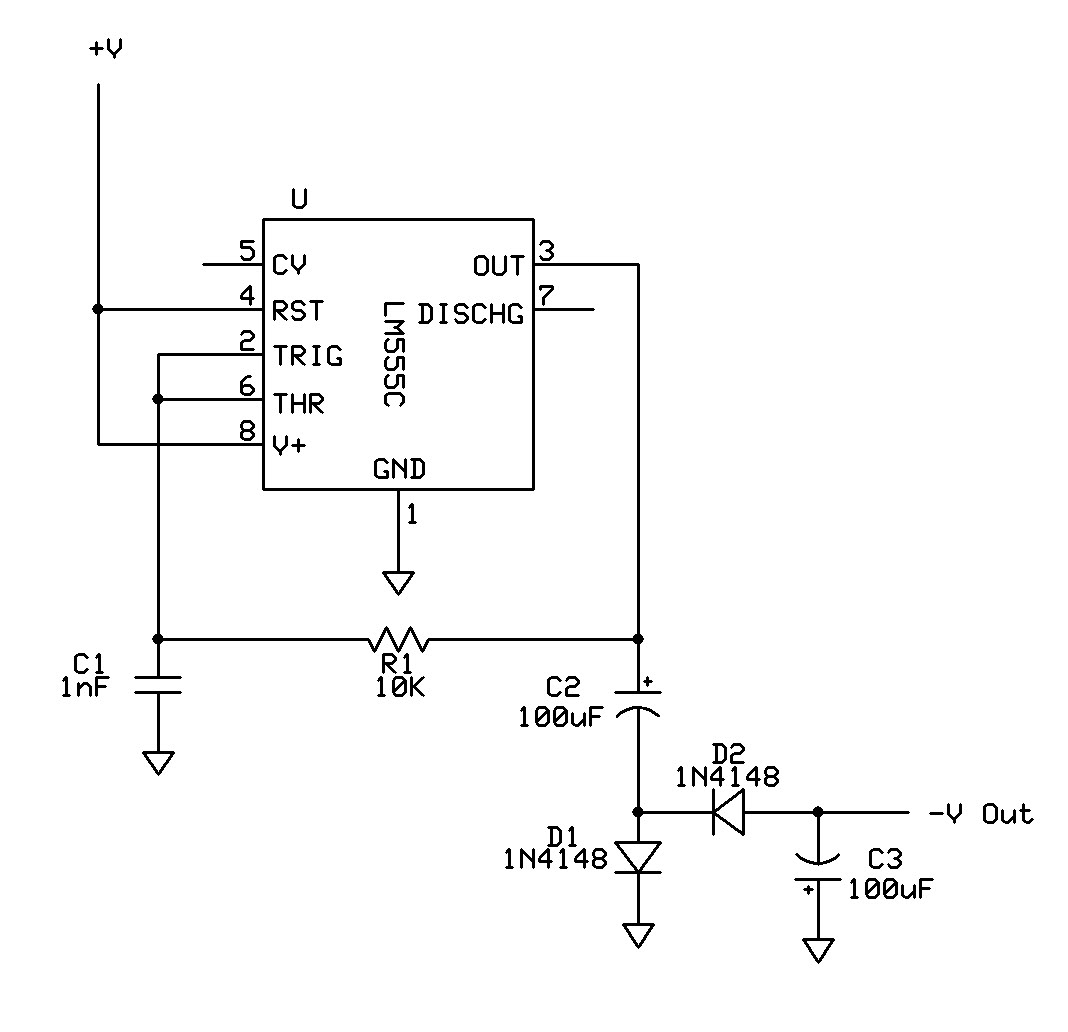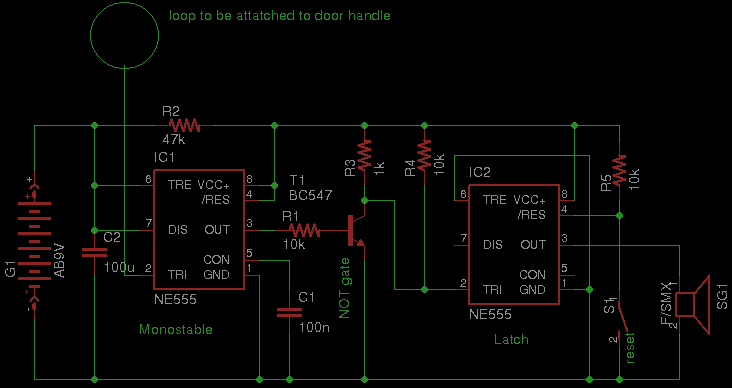
Infrared Transmitter-Receiver with 555

The infrared transmitter and receiver circuit depicted in the schematic diagram can function as a remote control system. The transmitter operates as an oscillator circuit, with the frequency adjustable through the R1 potentiometer (or trimmer pot). This oscillation ensures that the signal is distinguishable from other sources by the receiver. The receiver acts as a bandpass filter that eliminates noise signals. The frequency of this filter is determined by the inductance (L) and capacitance (C) in the feedback path, which connects the output to the inverting input of the operational amplifier (op-amp). The diode (D1) is included in the feedback path to rectify very small signals, as the op-amp feedback mechanism compensates for the forward voltage drop of the diode. The final op-amp in the circuit serves as a comparator, with its threshold adjustable via the R3 potentiometer. The op-amp requires a power supply of +12V and -12V for proper operation, while the R3 potentiometer is supplied with -12V.
The infrared transmitter circuit is designed to modulate a carrier frequency that can be tuned with the R1 potentiometer. This allows for fine-tuning of the frequency, enhancing the ability of the receiver to detect the transmitted signal amidst potential interference from other infrared sources. The transmitter typically consists of a light-emitting diode (LED) that emits infrared light when energized, and the modulation ensures that the signal can be effectively captured by the receiver.
The receiver circuit includes a bandpass filter designed to isolate the frequency of interest while filtering out unwanted signals. This is achieved through the careful selection of L and C components, which set the resonant frequency of the filter. The operational amplifier plays a critical role in amplifying the filtered signal. The inclusion of diode D1 in the feedback loop is essential for rectifying low-level signals, allowing the circuit to operate effectively even with minimal input.
The comparator function of the final op-amp enables the detection of the received signal level against a set threshold. The R3 potentiometer allows for adjustment of this threshold, providing flexibility in the sensitivity of the receiver. This is particularly useful in environments with varying levels of ambient infrared noise. The power supply requirements of +12V for the op-amp and -12V for the potentiometer ensure that the circuit operates within its optimal range, facilitating reliable performance in remote control applications. Overall, this infrared transmitter and receiver circuit exemplifies a practical solution for wireless control systems, leveraging the principles of modulation, filtering, and signal amplification.Infrared transmitter and receiver circuit shown in the schematic diagram below can be used as remote control. The transmitter is basically an oscillator circuit, and the frequency can be adjusted using R1 potentiometer (or trimmer pot).
This oscillation makes sure if the signal can be distinguished from other source by the receiver. The receiver is actually a bandpass filter which filter out noise signal. The frequency of this filter is determined by L and C in the feedback path (from output to inverting input of the op-amp). D1 is inserted in the feedback path to enable rectifying very small signal, since the op-amp feedback mechanism will compensate the forward drop voltage of the diode.
The last op-amp is employed as a comparator, with the threshold is adjustable via R3 potentiometer. The op-amp should be supplied with + and 12Volt, and the R3 potentiometer should be supplied with -12V. [Circuit`s schematic diagram source: hobbyprojects. com] 🔗 External reference
The infrared transmitter circuit is designed to modulate a carrier frequency that can be tuned with the R1 potentiometer. This allows for fine-tuning of the frequency, enhancing the ability of the receiver to detect the transmitted signal amidst potential interference from other infrared sources. The transmitter typically consists of a light-emitting diode (LED) that emits infrared light when energized, and the modulation ensures that the signal can be effectively captured by the receiver.
The receiver circuit includes a bandpass filter designed to isolate the frequency of interest while filtering out unwanted signals. This is achieved through the careful selection of L and C components, which set the resonant frequency of the filter. The operational amplifier plays a critical role in amplifying the filtered signal. The inclusion of diode D1 in the feedback loop is essential for rectifying low-level signals, allowing the circuit to operate effectively even with minimal input.
The comparator function of the final op-amp enables the detection of the received signal level against a set threshold. The R3 potentiometer allows for adjustment of this threshold, providing flexibility in the sensitivity of the receiver. This is particularly useful in environments with varying levels of ambient infrared noise. The power supply requirements of +12V for the op-amp and -12V for the potentiometer ensure that the circuit operates within its optimal range, facilitating reliable performance in remote control applications. Overall, this infrared transmitter and receiver circuit exemplifies a practical solution for wireless control systems, leveraging the principles of modulation, filtering, and signal amplification.Infrared transmitter and receiver circuit shown in the schematic diagram below can be used as remote control. The transmitter is basically an oscillator circuit, and the frequency can be adjusted using R1 potentiometer (or trimmer pot).
This oscillation makes sure if the signal can be distinguished from other source by the receiver. The receiver is actually a bandpass filter which filter out noise signal. The frequency of this filter is determined by L and C in the feedback path (from output to inverting input of the op-amp). D1 is inserted in the feedback path to enable rectifying very small signal, since the op-amp feedback mechanism will compensate the forward drop voltage of the diode.
The last op-amp is employed as a comparator, with the threshold is adjustable via R3 potentiometer. The op-amp should be supplied with + and 12Volt, and the R3 potentiometer should be supplied with -12V. [Circuit`s schematic diagram source: hobbyprojects. com] 🔗 External reference
